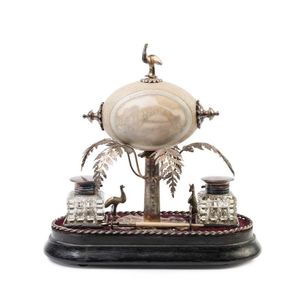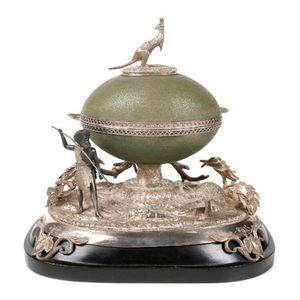Silver Mounted Emu Egg with Australian Diorama
You must be a subscriber, and be logged in to view price and dealer details.
Subscribe Now to view actual auction price for this item
When you subscribe, you have the option of setting the currency in which to display prices to $Au, $US, $NZ or Stg.
- Diorama - When used in relation to antiques and collectables, a diorama is a three dimensional display, usually within a domed or rectangular glass case.
As the feathers of birds are more easily damaged than the skin of an animal, most taxidermied birds are displayed within a glazed diorama. The birds will be set in lifelike poses in a naturalistic landscape, usually standing a branch within the diorama. Animals will be displayed set in the landscape they inhabit. The foreground will be set with gravel, rocks and bushes, while the background will be painted.
While most natural history dioramas can be easily picked up and carried by one person, some larger examples were made that were suitable for display at exhibitions.
The other type of diorama commonly seen is a model ship enclosed in a rectangular glass box, the ship depicted floating on the sea. - Finial - An architectural decoration, found on the upper parts of of an object. On furniture they are usually found on pediments, canopies and shelf supports. On smaller ceramic or silver items, such as spoons, they may decorate the top of the item itself, or the lid or cover where they provide a useful handle for removal.
Finials have a variety of shapes and forms. They may be urn-shaped, baluster shaped round or spiral, but usually taper into an upper point. Many real life shapes may also be used as finials, such as pineapples, berries, pinecones, buds, lotus and acorns. Sometimes animals such as a lion are depicted, or fish and dolphins.
This item has been included into following indexes:
Visually similar items

A George III silver sauce tureen and cover, Rebecca Eames & Edward Barnard / London / 1813, the stepped domed cover with a gadrooned border, the body with a conforming border to the rim, flanked by angular handles, bun feet, approximately 586gms, 21 cm wid

An Indian silver three piece tea set and tray, Kutch India early 20th century, comprising a coffee pot, milk jug, sugar pot and tray

An Australian silver plated mounted emu egg desk set carved with Sydney Harbour Bridge, circa 1933, 28 cm high, 28m wide, 16 cm deep

A Chinese bronze vessel in the archaic manner, the patinated high shouldered baluster pot raised upon a flared circular foot, with applied rings to the side and a chain and bar handle, the collar and foot with a taotie embellished frieze on a diaper ground
